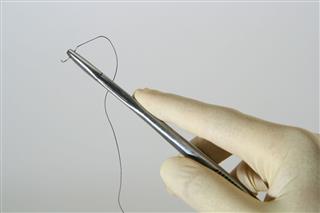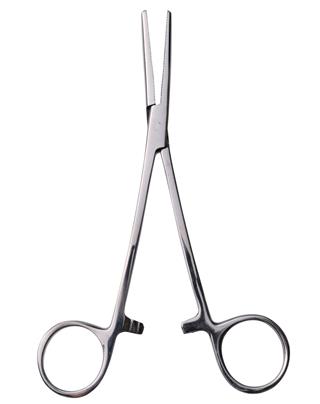
With so many surgical instruments used today, one is eager to know about their specific tasks. The following article provides information about basic surgical instruments and their uses.
Did You Know?
To prevent any sort of infection during surgery, sterilization of instruments was first proposed by Louis Pasteur, a French chemist in 1878.
Importance of Surgical Instruments
A surgery cannot be carried out without medical tests and tools. There are a variety of surgical instruments, each designed for a specific purpose. Some are used for making an incision while others are made to hold tissues. Using them correctly is necessary to prevent any irreversible damage to the internal organs of the body.
Basic Surgical Instruments and Their Uses
- Scalpel
- Surgical Staples
- Surgical Suture
- Hemostat
- Dilator
- Scissors
- Curette
- Forceps
- Retractors
- Surgical Elevator
- Probe
- Needle Holder
Information about the most frequently used surgical instruments with their pictures is given below:
Scalpel

This is a surgical knife that comes with a sharp stainless steel blade. Whether it is a minor or a major surgery, a correct surgical incision is a must, which is not possible without a scalpel. Each and every surgery has its own specific needs. For instance, a minor surgery will require a small incision whereas a major surgery may demand an incision deep into the skin tissues. So taking this into consideration, scalpels are manufactured in a variety of sizes. The blades of scalpel are detachable and many times this instrument is designed for one time use only.
Surgical Staples

Talking about list of surgical instruments and one simply cannot forget to mention about surgical staples. Normally, an incision made or an open wound that occurs during surgery cannot be left open as it can trigger internal bleeding. A common practice is to seal these cuts using stitches but nowadays surgeons prefer to use surgical staples instead of stitches. The main advantage is that the possibility of blood leaking from a wound closed by a surgical staple is minimal. Apart from closing the incision, surgical staples are also useful to reattach and remove portions of certain organs. For instance, a bowel surgery may demand cutting certain parts of the intestine and reconnecting the remaining portion of the intestine. This can be effectively and precisely done using surgical staples.
Surgical Suture
As we all know, during surgery incisions are made to carry out the procedure. Surgical sutures, which are nothing but stitches, are commonly used to reconnect the tissues so as to close the incision after the surgical procedure is over. Sutures also help to join wound edges after an injury. This closing of wound helps to facilitate healing of the injury. Modern sutures are made from synthetic material that can be either absorbable or non-absorbable one.
Absorbable Sutures
Absorbable sutures are absorbed by the body over a course of time. The duration of absorption varies according to the type of suture material but lasts anywhere between 10 days to 2 months. When the suture is placed deep inside the body or the patient is not in a position to visit the hospital again to remove sutures, then the absorbable sutures are used. Absorbable sutures are primarily constructed from synthetic material like polylactic acid, polyglycolic acid, and caprolactone.
Non-absorbable Sutures
Non-absorbable sutures are non-biodegradable; hence cannot be broken down by the body and absorbed. The material used in making non-absorbable sutures is usually polypropylene, nylon, or polyester. Stainless steel wires that exhibit high tensile strength are often preferred to close the sternum following heart surgery. In general, non-absorbable sutures have an advantage over their counterparts, as they cause minimal scarring. Usually these sutures are removed after a specified duration but in some cases, they are allowed to remain in the position.
Hemostat

During any surgical procedure, some amount of bleeding is there for sure. A slight incision here and there is followed by bleeding. In order to prevent any sort of major complications, the surgeon often uses a hemostat. This is a clamp-like surgical tool that is utilized to constrict a blood vessel, which helps to minimize or stop the flow of blood during any surgical procedure.
Dilator

Surgical procedures involving the esophagus, urethra, or the cervix often require the surgeon to enlarge the opening of these tubular structures. This can be done using dilators, instruments that expand the passage, thereby allowing the surgeon to access the organ and perform the surgeon properly. These tools induce dilation to open up a tube, duct or cavity for surgical purposes.
Scissors

This surgical instrument is mainly used to cut body tissues. Scissors used in surgery come in two main types: Mayo and Metzenbaum scissors. When it comes to cutting or dissecting soft delicate tissues, surgeons prefer the metzenbaum scissors. The Mayo scissors are used for cutting hard tissues such as joints. Thick tissues located in the breast and the muscles can also be cut using Mayo scissors. Usually, these scissors are made up of stainless steel and are manufactured in variable lengths.
Needle Holder

As we all know, stitching the body tissues that are cut at the time of surgery is a very important task. Even a slight mistake while sewing the tissue is likely to make the patient uncomfortable days after completing the surgery. An improperly sewn skin tissue can be a cause of great pain and may require another surgery to correct it. To avoid all these complications and to carry out sewing of tissues accurately, surgeons often make use of needle holders. These instruments allow the surgeon to hold the needle firmly while stitching the required tissue.
A needle holder that has a shape similar to a scissor, consists of straight, smooth jaws, joints and handles. It comes with a tungsten carbide inserts that are attached at the end of both the jaws. They ensure that the needle does not move while sewing tissues. In simple words, these instruments are designed to provide a strong grip on the needle, thereby substantially reducing the chances of any error during this stage of surgery.
Forceps
Forceps are like kitchen tongs that allow the surgeon to grasp and hold the skin tissues firmly. Whether it is holding a part of intestine or clamping the arteries during operation, one can always rely on these forceps. This surgical instrument comes in a range of sizes so that the surgeon can choose one depending upon his specific needs. Forceps that are designed to hold a baby’s head are quite large and their main purpose is to safely remove the baby from the birth canal during a cesarean.
Curette
This surgical tool resembling to a spoon is used for taking out unwanted tissue from internal body cavities. Using the tool, the surgeon simply scrapes to scoop out the abnormal tissue. Cleaning procedure such as removing cancer growth may require use of curette.
Retractors
When an incision is made, it has to be kept open during surgery. This job of keeping the incision wide open is done by retractors. These instruments are used to pull back the tissues so that the surgeon can easily access the operation site and perform the surgery without any hindrance. Sometimes even the organs have to be held back using retractors, so as to expose the surgical site to the desired level. Retractors are made available in different sizes and shapes. Also, there are different types of retractors and each one is designed to retract a specific organ. For instance, lung retractors may be used to push aside the lungs gently for getting an unobstructed view of the surgical site. So, be it a gallbladder surgery or a breast reduction surgery, it cannot be done without retractors.
Surgical Elevator
When it comes to performing oral surgery such as tooth extraction, it is not possible without a surgical elevator. This tool is commonly used in dentistry for removing or separating affected teeth from their sockets. It is also used for separating bones from their tissues.
Probe
A probe is a long, flexible surgical tool that has a blunt end and is used for probing a wound and body cavities such as a sinus tract. The instrument helps to evaluate the wound such as how deep the wound is. The direction of wound can also be assessed using this tool. As the instrument is inserted in the wound or cavity, excessive usage can trigger pain and cause pain in patients.
These are some of the basic surgical instruments and their uses. Keep in mind that it is important to choose a surgical tool that is appropriate for the procedure. Choosing the wrong tools can not only be traumatic for the patient but can also prevent the surgeon from doing his best work.




